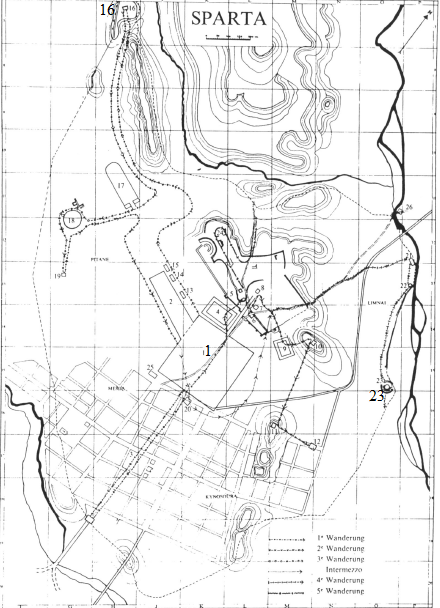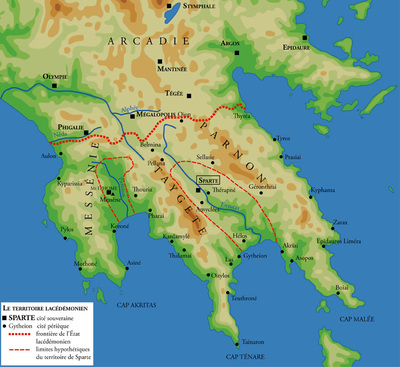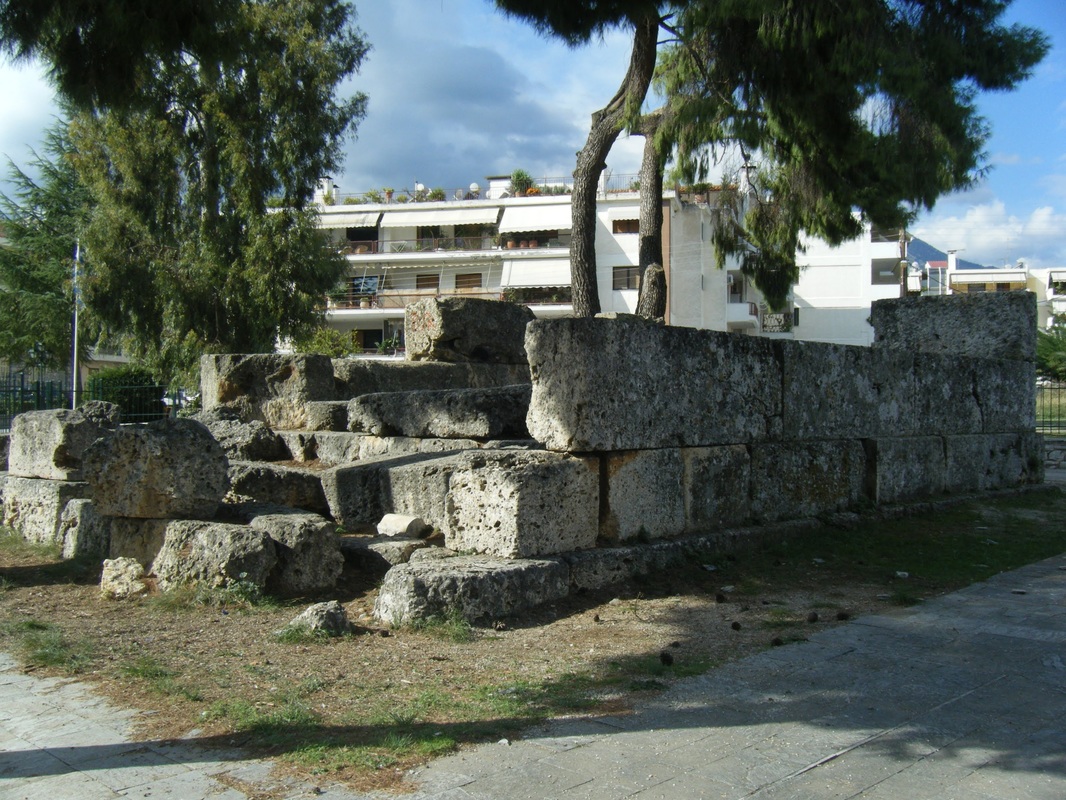The reflection of military culture in the classical city of Sparta
A reconstruction of the physical reality of a lost city
AbstractMy research is about the city-scape of Sparta. In no other Greek city was military prowess thought of as so beautiful as in the city of Sparta. I wondered in how far the physical reality of the Spartan city resembled this mentality. My research is even more interesting because of the few remains that are left of the city, which makes constructing an image of how living in the Classical Sparta town could have been, more challenging. The question that is central in my research is: Did the Classical city of Sparta reflect the militaristic characteristics of Spartan society? In this weebly you will find a shortened version of the outcome of my research essay.
|
Explanation of research |
Among the Greek poleis, which can be broadly defined as political entities where the power was held by a ruling body of those who were qualified as citizens, Sparta was by far the most militaristic. It’s social system and constitution were almost completely dedicated to military training and excellence. It appears that in the polis of Sparta, the warrior spirit and military greatness were seen as beautiful above all else. About the physical appearance of the city of Sparta however, not particularly much is known. As a consequence of the simple lifestyle the Spartans liked to live, the city was not made remarkably spectacular with grand buildings and temples that were generally typical for ancient Greek cities. This, and the reasonably early decline of the city from 370 BC onward, has led to the fact that there are not many remains to be found of the once so powerful city. In my research I thus wanted to find out as much as I could about the physical reality of the city in its period of glory, and if that in any way reflected the militaristic nature of the Spartan society. By physical reality I mean the buildings and structures in the city, but also the cults and festivals that were held because they were also a part of the cityscape.
|
explanation of primary sources |
Since archeologically Sparta is a bit of a problem, I had to rely on written accounts of ancient figures to discover more about the city. The most important literary sources on Sparta were written by Thucydides, Xenophon, Plutarch and Pausanias. The first two lived during the heyday of Sparta, whilst the other two visited the city in decline in the second century AD. When using written sources you must always take the personal background and motivation of the writers into account, because they might have had an impact on how they wanted to portray things. Thucydides for instance was an Athenian, and since Athens and Sparta have had numerous conflicts with each other, we must consider the possibility of an Athenian-based view when looking at his writings. Xenophon on the other hand might have been too biased towards Sparta. His deep admiration for Spartan society might have let him to hold back certain information that was negative about Sparta, or it might have made him portray things more beautiful than they really were. With the writings of Pausanias and Plutarch we must of course take into account the vast amount of time that has passed between Sparta’s glory and their visits to the old city. Despite these marginal notes, the literary sources have been proven to be very useful in my research.
|
results of research
Archaeology |

So what did the city look like? Using Pausanias reports plus the findings of archaeologists, various historians have drawn their maps of Sparta. A notable effort was that of the German Stibbe, who tried to figure out the possible routes that Pausanias could have taken while making his tour around the city.
This gives us a good view of where the buildings and sites were most likely located. With for example 1 being the market place, 23 the sanctuary of Artemis Ortha, and 16 at the top the sanctuary of Artemis Isoria. The most notable information for my research that the archaeologists reveal however is the absence of city walls for Classical Sparta. A possible consequence of the strategic location of the town between two mountain ridges. Another reason however could be the confidence the Spartans had in their military capability. In Plutarch’s Moralia the Spartan lawmaker Lycurgus when asked about the lack of fortifications of the city apparently said that a city is not well defended when it has a wall of stone, but when it has a wall of capable men.[1] For an idea how the city really looked like however we’ll have to look at the descriptions of Pausanias and Plutarch themselves. And of course I had to focus on the military aspect of the city. [1] Plutarch, Moralia, 228, E, 28. |
Written accounts |
What stands out in the accounts of Pausanias are the numerous funerary monuments and altars he describes, which were erected for soldiers that died valiantly in battle. An example of this is the sanctuary for a certain Maron and Alpheius, two soldiers who apparently fought as valiant as Leonidas himself. When Pausanias enters the marketplace, he describes the arc that is the entrance, which is decorated with the spoils from the war with the Persians. As well in the representation of the gods we can find the military characteristics. According to Plutarch, the gods were depicted in arms because in Sparta all the gods were connected to warfare. This is also mentioned by Pausanias. This was done to inspire young Spartans on their journey to adulthood and their role as warriors. The tomb of Leonidas, which is actually still to be seen in Sparta today, is also described, though it is doubted whether Leonidas remains were actually buried there.[2]
[2] Pausanias, Description of Greece. |
The remains of the tomb in modern day Sparti.
Cults, festivals and rituals |
Also in the cults, festivals and rituals that were held in Sparta we can clearly find again the influence of warfare. The three big yearly festivals were called the Hyakinthia, the Karneia and Gymnopaidiai, which all were connected in a big way to warfare. During the Hyakinthia Spartans gathered at a 9 meters tall statue of Apollo in battle equipment to commemorate the death of the Spartan hero Hyacintus. During this festival the division of the Spartan society in age classes was reaffirmed. The Gymnopaidia were closest connected to warfare, as this festival was purely held to appease the gods for success in battle. If you were in Sparta at the time of this festival, you would see naked young Spartans dancing in a military drill style way.[3] Apart from the three big festivals there were numerous examples of rituals and athletic competitions that had to do with warfare. Xenophon sums this up quite nicely in his Constitution of the Lacedaimonians: “And so […] you would think all other men mere improvisers in soldiering and the Lacedaemonians(Spartans) the only artists in warfare.”[4]
[3] Cartledge, Spartan reflections, 86. [4] Xenophon Constitution of the Lacedaimonians, 13.5. |
References |
For more about Stibbe's map of Sparta see: Stibbe, C.M., Das andere Sparta, Zabern Philipp von GmbH: 1996.
Cartledge, Paul. Spartan Reflections, Duckworth, London: 2001.
Pausanias, Description of Greece: http://www.perseus.tufts.edu/hopper/text?doc=Perseus%3Atext%3A1999.01.0160
Plutarch, moralia: http://www.gutenberg.org/files/23639/23639-h/23639-h.htm
Xenophon Constitution of the Lacedaimonians: http://www.perseus.tufts.edu/hopper/text?doc=Perseus%3Atext%3A1999.01.0210%3Atext%3DConst.+Lac.
Cartledge, Paul. Spartan Reflections, Duckworth, London: 2001.
Pausanias, Description of Greece: http://www.perseus.tufts.edu/hopper/text?doc=Perseus%3Atext%3A1999.01.0160
Plutarch, moralia: http://www.gutenberg.org/files/23639/23639-h/23639-h.htm
Xenophon Constitution of the Lacedaimonians: http://www.perseus.tufts.edu/hopper/text?doc=Perseus%3Atext%3A1999.01.0210%3Atext%3DConst.+Lac.


